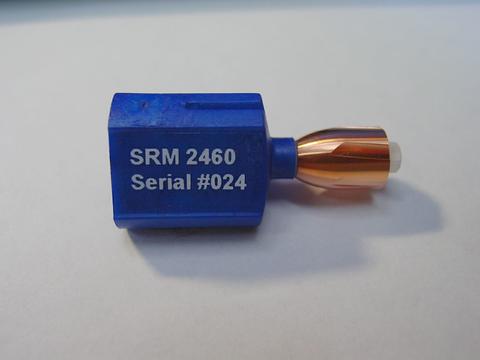
A NIST Standard Reference Material 2460 "standard bullet" mounted on a blue stub. Each one has six signature markings typically found in a fired bullet. SRM 2460 is intended primarily for use as a check for crime laboratories to help verify that the computerized optical equipment for bullet imaging and profiling is operating properly.
The National Institute of Standards and Technology (NIST) has announced a competition to create a Forensic Science Center of Excellence dedicated to collaborative, interdisciplinary research. The center's mission will be to establish a firm scientific foundation for the analytic techniques used in two important branches of forensic science, pattern evidence and digital evidence.
The seminal 2009 National Research Council report Strengthening Forensic Science in the United States – A Path Forward called for a thorough examination of the techniques used in forensic analysis to better understand their strengths and limitations. It also called for establishing scientifically rigorous standards and practices, including the development of tools and methods to better standardize analytical protocols.
Forensic investigations involve the collection of evidence, measurements of the evidence, analysis of those measurements and the determination of conclusions of known validity. One important goal is to develop so-called "probabilistic methods"—techniques that produce a quantifiable assessment of the likelihood that a given method produced a correct result. Forensic DNA analyses, for example, typically report the probability that an apparent match between two separate samples could come about by chance.
The new NIST-sponsored center will focus on developing probabilistic methods for dealing with pattern evidence and digital evidence. Pattern evidence encompasses much of what is typically thought of as forensic evidence: fingerprints, shoeprints, tire marks, tool marks, shell casing or bullet striations—anything that relies on comparing two sets of markings. Digital evidence includes such things as the data on cellphones or personal computers.
The planned center will work on scientific advances in probabilistic methods and information technology tools, as well as the necessary infrastructure to educate and train forensic science practitioners in using the new methods. The center will help expand NIST's expertise in the field and promote interactions between NIST, academia and various stakeholders in the forensic science community.
NIST anticipates funding the new center at about $4 million annually for five years, with the possibility of renewing the award for an additional five years. Funding is subject to the availability of funds through NIST's appropriations.
The competition is open to accredited institutions of higher education and nonprofit organizations located in the United States and its territories. The proposing institution may work as part of a consortium that could include other academic institutions; nonprofit organizations; companies; or state, tribal or local governments.
Full details of the solicitation, including eligibility requirements, selection criteria, legal requirements and the mechanism for submitting proposals are found in an announcement of Federal Funding Opportunity (FFO) posted at Grants.gov under funding opportunity 2014-NIST-FS-COE-01. See http://www.grants.gov/web/grants/view-opportunity.html?oppId=262395.
Applications will be accepted only through the Grants.gov website. The deadline for applications is 11:59 p.m. Eastern time, Dec. 11, 2014.
NIST will hold a webinar on the Forensic Science Center of Excellence within the next few weeks to offer general guidance on preparing proposals and provide an opportunity for the public to ask questions about the program. Participation in the webinar is not required to apply. There is no cost for the webinar, but participants must register in advance. Information on the webinar will be post on www.nist.gov/coe/forensics/ as soon as it becomes available.
This Center of Excellence is one of several NIST plans to establish to provide an interdisciplinary environment where researchers from NIST, academia, industry and government can collaborate on emerging areas of basic and applied research and innovations in measurement science. On Dec. 3, 2013, NIST announced the establishment of a Center for Hierarchical Materials Design (CHiMaD) under a consortium led by Northwestern University that will pursue advanced materials research. A second NIST Center of Excellence to be focused on community disaster resilience is the subject of a current competition.

